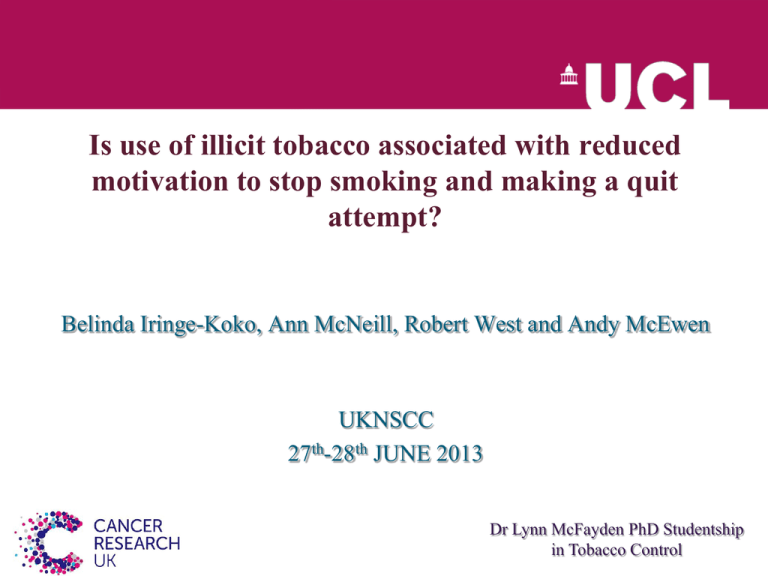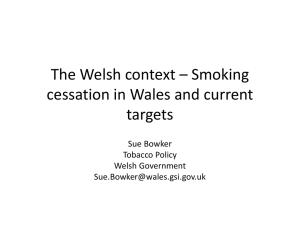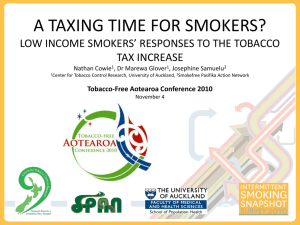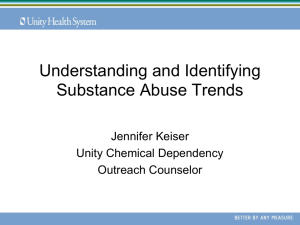to the presentation - UK National Smoking Cessation
advertisement

Is use of illicit tobacco associated with reduced motivation to stop smoking and making a quit attempt? Belinda Iringe-Koko, Ann McNeill, Robert West and Andy McEwen UKNSCC 27th-28th JUNE 2013 Dr Lynn McFayden PhD Studentship in Tobacco Control Illicit tobacco trade The existence of illicit tobacco undermines the effect tax rises (above the rate of inflation) have on encouraging smokers to quit and preventing the initiation of smoking. 11.6 % of the global cigarette market is illicit, costing governments across the world in excess of $40 billion in lost revenue (Joossens et al., 2009). In the UK the Illicit market share for cigarettes is 9% and 38% for HRT (2010-11). Costs the UK government £2 billion in lost revenue. Exacerbates health inequalities. Encourages smoking in young people. Illicit tobacco use and smoking cessation Hyland et al. (2005, 2006) Accessibility to a source of low-taxed or untaxed cigarettes reduces the likelihood that a smoker will make a quit attempt and successfully quit smoking. Luk et al. (2009) Recent purchase of illicit tobacco has been associated with having no plans to quit smoking. Licht et al (2009) Smokers who engage in any price/tax avoidance behaviours were 24% less likely to report quit attempts. Choi et al (2012) Smokers who used at least one price minimising strategy were less likely to attempt to quit smoking or cut back on cigarette consumption. Study Aim The aim of this study was to assess whether reported use of illicit tobacco was associated with motivation to quit smoking and having made a quit attempt in the past year. The current study sought to answer the following research questions: i. Are illicit tobacco users less likely to report any motivation to quit compared with smokers who purchased duty paid tobacco? ii. Is there an association between illicit tobacco use and having made a quit attempt in the past year? Methods The current study combined data from three surveys collected through the Smoking Toolkit Study, a monthly population based cross-sectional survey (www.smokinginengland.info). Data were collected in December 2007 and March to May 2008, December 2010 to May 2011 and May to December 2012. A total of 7,588 were current adult smokers aged 16+. Participants socio-demographics and smoking characteristics were recorded. Illicit Tobacco Purchase ‘In the last 6 months, have you bought any cigarettes or hand rolled tobacco from any of the following?: Newsagent\Off licence\Corner shop Newsagent\Off licence\Corner shop – Under the Counter Petrol garage shop Supermarket Cash and carry Internet Pub (behind the bar) Pub (vending machine) Pub (somebody who comes round selling cigarettes cheap) People who sell cheap cigarettes on the street People in the local area who are a ready supply of cheap cigarettes Buy them cheap from friends Buy them from abroad and bring them back with me Have not bought any in the last 6 months Don’t Know Motivation to Stop Scale (MTSS) (1) (2) (3) (4) (5) (6) (7) “I don’t want to stop smoking” “I think I should stop smoking but don’t really want to” “I want to stop smoking but haven’t thought about when” “I REALLY want to stop smoking but I don’t know when I will” “I want to stop smoking and hope to soon” “I REALLY want to stop smoking and intend to in the next 3 months” “I REALLY want to stop smoking and intend to in the next month” Past Quit Attempts Participants past quit attempts were assessed by asking: ‘How many serious attempts to stop smoking have you made in the last 12 months’? Demographic and Smoking characteristics of study participants Characteristics Age, (years) % (n) 16-24 25-34 35-44 45-54 55-64 65+ Gender, % (n) Male Female Social status, % (n) AB C1 C2 D E Type of Tobacco smoked, % (N) Cigarettes Cigarettes & RYO RYO only Cigarettes per day (CPD), mean (sd) Time to first cigarette,% (n) >61 minutes 31-60 minutes 6-30 minutes <5 minutes Made quit attempt, % (n) Motivation to quit, mean (SD) Levels of motivation, % (n): 1. ‘I don’t want to stop smoking’ 2. ‘I think I should stop smoking but don’t really want to’ 3. ‘I want to stop smoking but haven’t thought about when’ 4. ‘I REALLY want to stop smoking but I don’t know when I will’ 5. ‘I want to stop smoking and hope to soon’ 6. ‘I REALLY want to stop smoking and intend to in the next 3 months’ 7. ‘I REALLY want to stop smoking and intend to in the next month’ Total (n=6,776) Tobacco/Cigarette purchase source Illicit only (n=273) Duty paid and illicit (n=611) Duty paid only (n=5892) 19.0 (1288) 19.8 (1340) 20.8 (1408) 17.8 (1206) 12.7 (862) 9.9 (673) 14.3 (39) 16.5 (45) 21.6 (59) 21.2 (58) 15.0 (41) 11.4 (31) 27.0 (165) 19.3 (118) 22.7 (139) 18.8 (115) 9.0 (55) 3.3 (20) 18.4 (1084) 20.0 (1177) 20.5 (1210) 17.5 (1033) 13.0 (766) 10.6 (622) 53.3 (3614) 46.7 (3162) 63.4 (173) 36.6 (100) 63.3 (387) 36.7 (224) 51.8 (3054) 48.2 (2838) 15.2 (1033) 25.1 (1700) 25.1 (1703) 20.8 (1412) 13.7 (929) 9.2 (25) 15.4 (42) 27.5 (75) 27.1 (74) 20.9 (57) 10.9 (67) 23.9 (146) 29.1 (178) 22.5 (138) 13.6 (83) 16.0 (941) 25.7 (1512) 24.6 (1450) 20.4 (1200) 13.4 (789) 59.6(3457) 7.1(414) 33.2(1928) 12.5 (8.38) 31.5(74) 5.1(12) 63.4(149) 13.8 (9.10) 46.2(258) 15.6(87) 38.2(213) 14.5 (8.55) 62.4(3125) 6.3(315) 31.3(1566) 12.2 (8.29) 27.1 (1835) 22.0 (1494) 31.5 (2136) 18.9 (1281) 31.7 (2150) 3.6(2.07) 27.0 (74) 13.1 (36) 35.4 (97) 24.1 (66) 26.6 (73) 3.0(1.90) 21.6 (132) 19.1 (117) 34.5 (211) 24.2 (148) 35.9 (219) 3.5(1.94) 27.7 (1629) 22.8 (1341) 31.0 (1828) 18.1 (1067) 31.6 (1858) 3.6 (2.08) 25.5(1345) 12.6(662) 37.3 (81) 11.5 (25) 22.3 (84) 15.2 (57) 25.2(1180) 12.4 (580) 8.9(471) 9.2 (20) 9.8 (37) 8.8 (414) 17.1(899) 15.2 (33) 15.7 (59) 17.2 (807) 14.9 (786) 9.5 (500) 16.6 (36) 6.0 (13) 21.3 (80) 7.4 (28) 14.3 (670) 9.8 (459) 11.6 (609) 4.1 (9) 8.2 (31) 12.2 (569) p Value p<0.001 p<0.001 p<0.001 p<0.001 p<0.001 p<0.001 p = 0.016 p<0.001 p<0.001 Results [1] Table 1: Association between any use of illicit tobacco and motivation to quit and having made a quit attempt in the previous year Unadjusted OR (95% CI) Motivation to quit Smoking Duty paid only Duty paid and illicit Illicit only Past quit attempt Duty paid only Duty paid and illicit Illicit only p value Adjusted ORa (95% CI) p value Reference Reference 0.95 (0.90 – 1.00) 0.058 0.94 (0.89 – 0.99) 0.033 0.86 (0.81 – 0.93) p<0.001 0.87 (0.81 – 0.94) p<0.001 Reference 0.84 (0.66 – 1.06) 0.147 1.01 (0.74 – 1.38) 0.957 Reference 0.88 (0.69 – 1.12) 0.296 1.02 (0.74 – 1.41) 0.892 Results [2] Table 2: Adjusted odds ratio (aOR) of illicit tobacco, duty paid and illicit tobacco purchase for the various levels of motivation Levels of motivation 1. ‘I don’t want to stop smoking’ 2. ‘I think I should stop smoking but don’t really want to’ 3. ‘I want to stop smoking but haven’t thought about when’ 4. ‘I REALLY want to stop smoking but I don’t know when I will’ 5. ‘I want to stop smoking and hope to soon’ 6. ‘I REALLY want to stop smoking and intend to in the next 3 months’ 7. ‘I REALLY want to stop smoking and intend to in the next month’ Illicit only aOR (95% CI) p value Duty paid and illicit aOR (95% CI) p value 3.47 (1.80 – 6.70) p<0.001 1.50 (0.97 – 2.31) p=0.067 2.08 (1.00 – 4.33) p=0.050 2.19 (1.40 – 3.42) p=0.001 2.78 (1.33 – 5.82) p=0.007 1.62 (0.99 – 2.66) p=0.055 2.22 (1.12 – 4.40) p=0.022 1.15 (0.73 – 1.80) p=0.552 2.80 (1.42 – 5.52) p=0.003 1.82 (1.18 – 2.80) p=0.007 1.48 (0.67 – 3.30) p=0.335 1.21 (0.73 – 2.00) p=0.464 Reference Reference Discussion Illicit tobacco users being less motivated to stop smoking is possibly as a result of their ability to access cheap tobacco which reduces the financial motivation to quit. Smokers who used both duty paid and illicit sources (most likely opportunistic buyers of illicit tobacco) showed lower odds of reduced motivation to quit compared with exclusive illicit tobacco users. Use of illicit tobacco did not appear to discourage the making of quit attempts despite a negative association with motivation to stop. A possible explanation for this is that smokers’ in the current study may have been engaging in illicit tobacco purchase for some time, during which they could have made some attempts to quit smoking albeit unsuccessfully. Policy implications An effective approach to tackling illicit tobacco trade cannot focus solely on tackling supply through increased enforcement (although this is warranted) but also demand by targeting illicit tobacco users with specialised smoking cessation strategies to increase quit rates and reduce smoking prevalence. There is scope for targeted smoking cessation efforts that maybe more effective in achieving successful quit attempts in this group. Conclusion Illicit tobacco use appeared to be associated with reduced motivation to quit smoking. Further research is warranted to determine whether illicit tobacco users being less motivated to quit smoking is down to the availability of illicit tobacco, being able to obtain it at a cheap price or smokers’ social scene. Reports of any illicit tobacco use were not related to making a past quit attempt, but may impact on the success of quit attempts. In order to promote successful smoking cessation in smokers reporting illicit tobacco use, limiting the accessibility to illicit tobacco as well as more targeted smoking cessation interventions is recommended. Acknowledgements Dr Andy McEwen Professor Robert West Professor Ann McNeill UCL Tobacco Research Group belinda.iringe-koko.09@ucl.ac.uk www.smokinginengland.info Dr Lynn McFayden PhD Studentship in Tobacco Control





